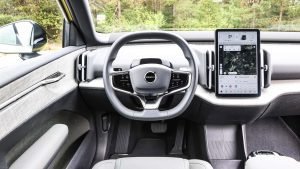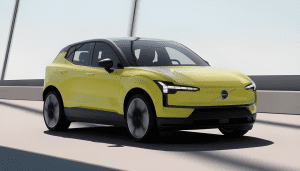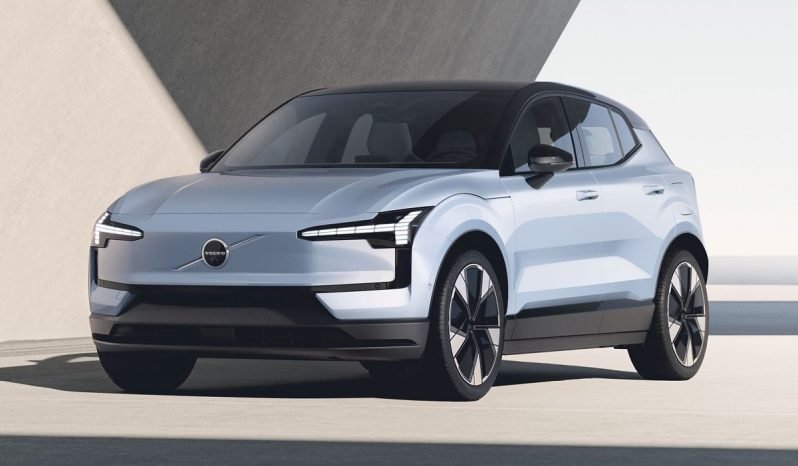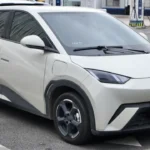In a recent development, Swedish Luxury Auto Manufacturer, Volvo has announced to go all-electric by 2030. The key markets, wiping out ICE and Hybrids completely from their portfolio, in a span of six years from now, includes India as well. Playing a major role in Volvo’s global EV expansion, India is to launch one EV, every year till the decided time-period concludes.
Following, the strategy of expanding the EV lineup, Volvo Car India has lined up two big launches for the coming year. The first model is a recently unveiled, entry-level offering in electric range, going by EX30. The EX30, will be followed by another model, aligned in a flagship segment, which is likely to be a cross-country version of this electric crossover. The second model will be named as EX90.
In this article, we’ll discuss on what the most affordable entry-level Volvo EV, bring to the table, having an upper hand over the competition.
Dimensions:
The Volvo EX30, is an over 4m electric crossover, measuring 4233 mm in length, 1836 mm in width and 1549 mm in height. To offer a stable driving dynamics in urban and sub-urbans, this most affordable, entry-level electric Volvo features a class leading ground clearance of 170 mm, equivalent to 17 cm. The cabin space is also uncompromised with an excellent wheelbase of 1800 mm, ensuring a comfortable accommodation of all three passengers in this five-seater, even on longer journeys.
With the EX30, Volvo has made sure that the smaller dimensions don’t affect the luggage compartment, providing a boot space of 318 L, so a maximum fitment of luggage could be possible.
Design:
Slotting between, the Volvo XC40 Recharge, EX30 holds differentiating styling factor to the current Volvo Car India’s EV lineup. The EX30, draws inspiration from its cross-country flagship sibling in terms of overall design and looks.
Following a minimalist design approach on the exterior, the front fascia hoists a Volvo logo on a closed-off grille, accompanied by a Y- shaped yet pixelated multi-functional day time running lights (DRL), also working as sequential LED side blinkers. The lower end of front bumper has a placement for the all-LED matrix headlight setup.
The door holds, electronic pop-up handle bars, intensifying the technological advancement of this electric crossover. Rear profile ends with a C-shaped, split but connected all-LED taillight, in a similar pixelated theme as the front day time running lights (DRL) on the tailgate. Underpinned on the Sustainable Experience Architecture (SEA), the EX30 drives on an aerodynamically designed 20-inch, painted black alloy wheels.
Features:
Volvo offers buyers a choice of four distinct interior options. These include renewable linseed plant fiber and specially recycled denim. Another option features a wool blend with 70% recycled polyester, while a structured knit material is made from recycled plastics.
Additionally, Nordico upholstery combines materials from forests and recycled plastics. These selections aim to provide environmentally responsible and varied interior choices for customers.
The cabin utilizes a dual-tone, black and denim treatment on the dashboard layout and the leatherette upholstery. The interior feels modern; at the same time tech-savvy, boasting features such as, a lightweight electronic 3-spoke steering wheel, automated dual-zone climate control system, electronically-adjustable front seats, also featuring heating function.
Other highlights, which adds value to the overall package include, a vertically stacked 12.3- inch touch sensitive infotainment screen. This TFT display, also supports wireless Android Auto and Apple Car Play along with the connected car technology. Apart from this, the centre-of-attraction remains a heads-up-display (HUD) based, digital instrument cluster.
The front bumper houses the Level-1 ADAS radar, continued by a front camera on the silhouette as a part of the 360-degree bird view. A 9-speaker Harman Kardon surround sound system, is also a part of the package to amplify the musical experience inside. An auto-dimming IRVM has been provided to augment the night visibility.
Wireless charging and a panoramic sunroof, for elevating the cabin’s airiness are also on offer. It is still doubtful, whether the heated ORVMs, regenerative braking and the automated parking, will feature in the EX30. (These all features are a part of global model of EX30, which are likely to be retained with the India-spec version)



Powertrain:
Volvo offers the EX30 globally with three different powertrains and two battery pack options. The smallest battery pack is a 49 kWh unit, which powers a single motor. This motor produces 268.28 bhp and 343 Nm of peak torque. This battery provides a total range of 337 km on a single charge and uses a Rear-Wheel Drive (RWD) configuration.
The mid-range variant of the EX30 is equipped with a 65 kWh battery pack, powering a single motor and providing an extended range of 476 km on a single charge. The power and torque figures are similar to the 49 kWh version, and it also utilizes a Rear-Wheel Drive (RWD) configuration.
The top-range variant features a 65 kWh battery powering a dual-motor setup. This trim offers a range of approximately 450 km on a single charge, with a peak power output of 422.14 bhp and a maximum torque of 543 Nm. It operates on an All-Wheel Drive (AWD) configuration.
The exact dates for the Volvo EX30 have not been released, though its debut in India is confirmed in 2025. After its launch, the EX30 will rival the likes of Hyundai Ioniq 5 and Kia EV6, priced between a tag of Rs 50 lakh (ex-showroom).






